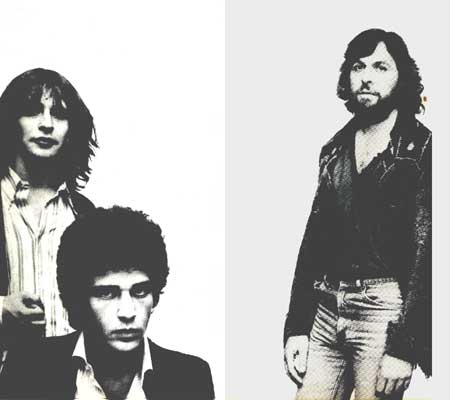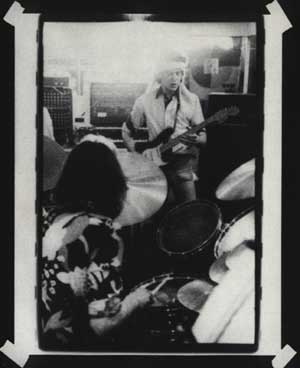|
BACK
TO HELDON
Okay, last issue's article about Heldon just wasn't
that great. It was written in my oft-bogus 'as
it's happening' style. I think it was a fine example
of that style, but hey, the thing about oft-bogus
styles is that they're often bogus. What's more,
the article ended before I had really listened
to the 5th, 6th, and 7th Heldon albums (Un
Reve Sans Consequence Special, Interface,
and Stand By respectively),
which are crucial pieces of the puzzle.
While the article did have
some great pictures,
 its
premature ending did not clearly state any real
thesis at all except a vague "I might quit making
fun of this stuff because the more I listen to
it I realize that I like it." Now that I like
it so much I'm listening to it every day, I would
like to offer this revisitation of the Heldon
topic, in order to state two theses of a more
well-considered nature, which I have arrived at
after said ongoing study. its
premature ending did not clearly state any real
thesis at all except a vague "I might quit making
fun of this stuff because the more I listen to
it I realize that I like it." Now that I like
it so much I'm listening to it every day, I would
like to offer this revisitation of the Heldon
topic, in order to state two theses of a more
well-considered nature, which I have arrived at
after said ongoing study.
THESIS ONE: Though often described as a 'prog
rock' band, Heldon is better described as one
of the first 'drone rock' bands. Off-kilter Euro-prog
elements can be felt in Heldon's music, most overtly
with the 7th and final album, Stand By,
and in Heldon founder/leader Richard Pinhas's
later solo work, such as the rather dreadful East/West.
However, I equate 'prog' more with the complex
multiple-riff music of early Genesis, Gentle Giant,
Yes, King Crimson, and et al, as well as with
their more underground contemporaries, the 'Canterbury'
school of bands, and Heldon isn't even vaguely
comparable to any of the above. Of course prog
has a broader definition than this, but I think
most will agree that for something to be 'prog'
it should exhibit skilled musicianship of some
kind along with multi-part 'suite-like' song forms.
In short, an extensive fusion between rock, classical,
folk,
and jazz music(s), and believe me, the end result
usually sounds just as stuffy. Heldon is barely
any of these genres. Heldon does have Pinhas's
electric guitar soloing, which is in fact very
prog, but every other element of the band, especially
on the first three discs, is much more primitive,
as in the very first rumblings of something new
kind of music, that is barely even rock and roll,
even though that's Heldon's final description
of it. (See their second album, "It's
Always Rock & Roll".) With supreme
millenial irony, the primitivism comes almost
entirely from a once-futuristic ARP synthesizer,
as most Heldon pieces are centered around one
simple synth drone, more of a cybernetic cycle
given sound-form than the 'suites' and 'movements'
and 'arias' that most progressive rock bands depend
on.
THESIS
TWO: There are two phases to Heldon's oeuvre.
The first phase was a more serene and dreamy solo
approach by Pinhas. On the 1974 debut Electronique
Guerilla, there are only two tracks that are
not Pinhas solo. On the second album Allez
Teia, Heldon has become a duo with the addition
of Georges Grunblatt on guitar, synthesizers,
and mellotron. The third album, the double LP
"It's Always Rock and Roll",
is Pinhas solo for 4 of the 9 tracks. All of these
albums are heavy on the aforementioned cybernetic
synthesizer drone, but despite its inherently
cold and menacing machine-sound, there is an overriding
'pastoral' quality about these records, what one
webzine referred to as something like "an
odd serenity at the center." This is because
this is largely solo music, just as immediate
'future-pastoral' predecessors like Popol Vuh
and Tangerine Dream (mach 2) were centered around
solo dronescapes crafted by Florian Fricke and
Edgar Froese respectively.
Heldon moved far beyond these preliminary influences
with its fifth and sixth albums, Un
Reve Sans
Consequence Special
and Interface. Here,
Pinhas's revolving cast of supporting characters
started to firm into a power trio lineup. All
but 8 minutes of Un Reve were trio works,
and all tracks featured Pinhas's drones and solos
pinned down by enormous John Bonham backbeats
by one Francois Auger. All but 2 tracks featured
one Patrick Gauthier playing monster Mini-Moog
basslines. On the next album, Interface,
this trio played 6 of the 8 tracks. (Both albums
feature a sizzling Pinhas/Auger duo as well as
one track on which Gauthier is pinch-hit for by
the splendidly named Didier Batard (of
legendary zuhl rockers Magma) on
bass.

These
albums display a sound incomparable to anything
that had come before. Heldon
didn't abandon the droning layered electro-pulse,
but developed it into a much heavier future-shock
sound that has actually been called 'electronic
punk,' also described by Jimmy Johnson on the Forced
Exposure website as "an intense jamming throb" and
"a crushingly dense synthesis of loud sounds." The
hard edge that could always be felt in Pinhas's
psybernetic drone-patches was fully accentuated
by Augier's monstrous disco breakbeats. Gauthier,
with what Pinhas described as "his brilliant
sophistic mind," made the cybernetic interweavings
of Heldon's sound more complex and dizzying than
before by adding angular low-end melodies that overlapped
hypnotically with Pinhas's
layers of electro-pulse.
This increased complexity can certainly suggest
a 'prog' tag, but that Heldon drone never goes
away. Rather than having multiple 'movements'
on several different vocal and instrumental themes,
Heldon creates their multiple movements only out
of the barely different psybernetic combinations
that can occur within one single 'aumgn' tonality.
When this dense machine stew is underpinned by
the life-force of Auger's stunning free-form Bonhamesque
power drumming, Heldon achieve a swirling density
that has been described as "frightening" and "violent"
more than once, most memorably (on
some website that I didn't bookmark and can no
longer find) as staring into the open mouth at
the spinning, whirling teeth of a dangerous android!
(This just in: by doing a search for "heldon teeth"
on Google
I found it, the exact description (by
comic artist Matt Howarth) being "like
falling into a huge mechanoid maw full of gleaming
patchcord teeth."
Turns
out to be from Sonic
Curiosity, an extensive experimental music
website by Howarth.) In addition to this "gleaming
mechanoid maw" approach, Heldon also developed
a strange sort of lumbering rubbery low-end robot-elephant
funk -- Interface is weirdly funky like
this throughout, but for a blatant example listen
to "MVC II" from Un Reve Sans
Consequence Special,
with
Pinhas on various Moogs, Auger on drums, and Didier
Batard's bass guitar pinch-playing for Gauthier's
Mini-Moog. In either case Heldon sounded like
a gang of robots come to life, or like Robocop
mechanically marching down some inner-city alleyway
as he bears down on a criminal. (And
maybe that's an even earlier robocop pictured
on the cover of Interface?)
Stand
By,
the seventh and last album bearing the name of Heldon
(although a new one with lyrics by Norman Spinrad
is apparently in the works), is a favorite among
prog heads. This is understandable because it is
the only Heldon album to de-emphasize the drone
in favor of actual rock riffs, even if their end
result is still a near-hurricane of mad jazz-prog
fusion. It is certainly a heavy-ass album, but something
isn't quite right for me -- I miss the earlier albums
when a Heldon track was just 'one'  riff, a tranced-out bubbling/interweaving drone
stew. The more actual 'riffs' and 'movements' and
'changes' I hear, the more my 'prog dreck' flag
goes up. Simply put, I miss the primitivism. If
you're a wealthy primitivist, you should buy all
seven Heldon albums in order, definitely saving
Stand By for last. If you're a wealthy prog
head, you might want to go in reverse order.
And, if you're poor like most of us and don't volunteer
at a community radio station well-stocked with Heldon
discs like I do, go straight to either Un Reve
Sans Consequence Speciale or Interface and
you will find a sound like no other. (Interface
might be about two percent better than Un
Reve
Sans Consequence Special,
and anyway it has the best cover art of any
Heldon album .)
riff, a tranced-out bubbling/interweaving drone
stew. The more actual 'riffs' and 'movements' and
'changes' I hear, the more my 'prog dreck' flag
goes up. Simply put, I miss the primitivism. If
you're a wealthy primitivist, you should buy all
seven Heldon albums in order, definitely saving
Stand By for last. If you're a wealthy prog
head, you might want to go in reverse order.
And, if you're poor like most of us and don't volunteer
at a community radio station well-stocked with Heldon
discs like I do, go straight to either Un Reve
Sans Consequence Speciale or Interface and
you will find a sound like no other. (Interface
might be about two percent better than Un
Reve
Sans Consequence Special,
and anyway it has the best cover art of any
Heldon album .)
Pinhas has made statements that suggest he's no
longer all that proud of the early albums. I find
the first phase of Heldon quite mesmerizing and
certainly in the same league as the work it is inspired
by, but I can see why Pinhas would be down on it.
Upon analysis, it could actually be described as
'derivative,' where the later stuff is its own original
monster, for and of and from the space-age.
blastitude
number three's last page
|

